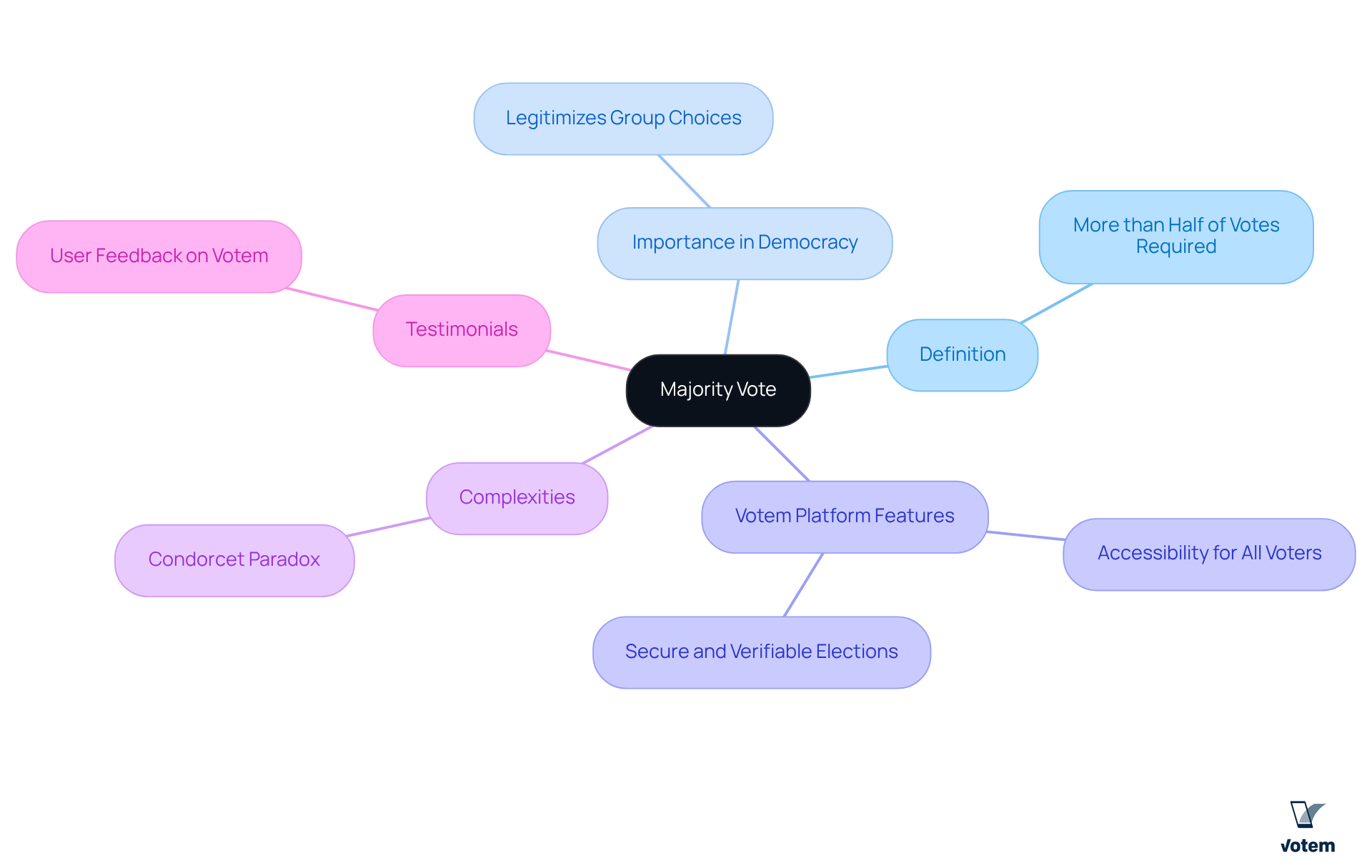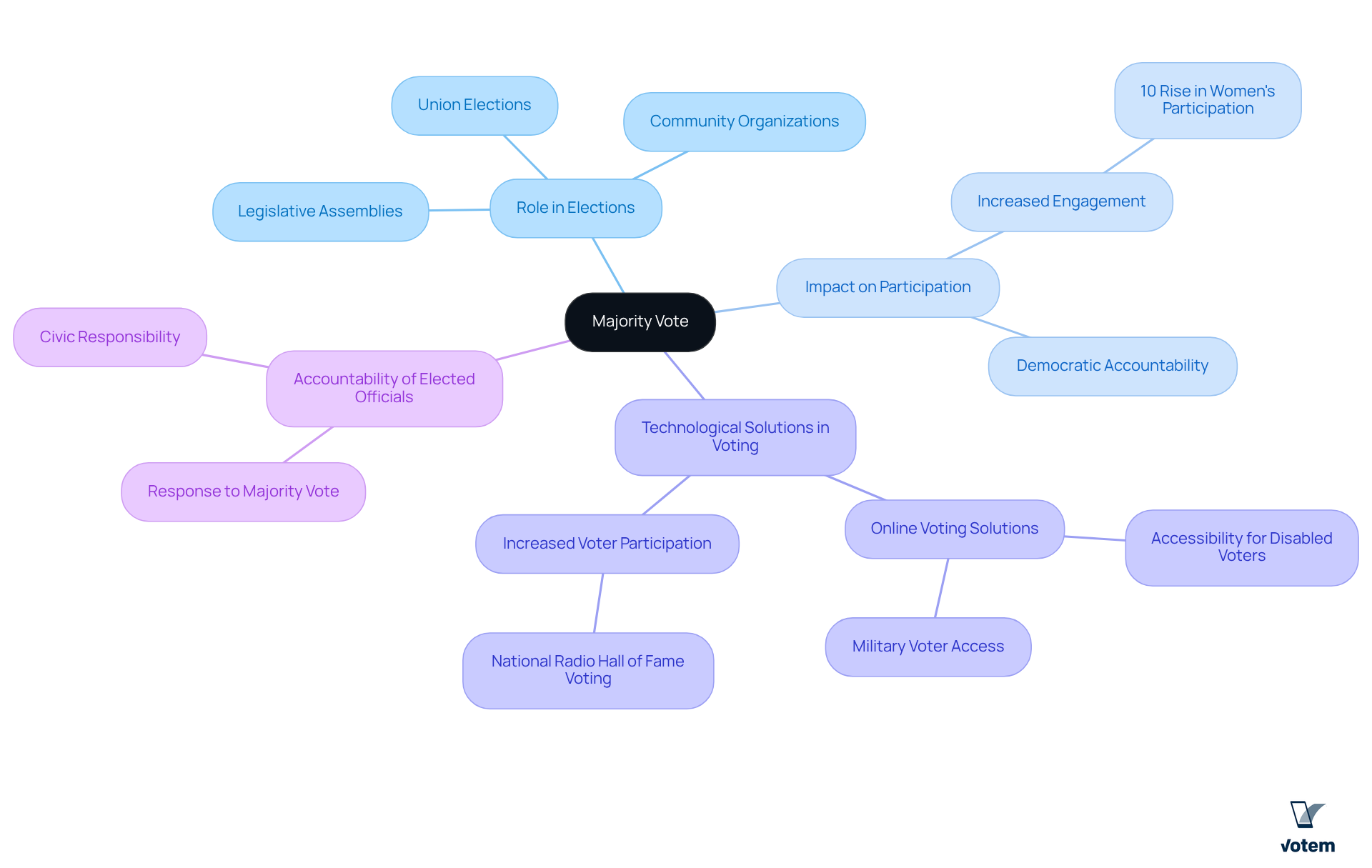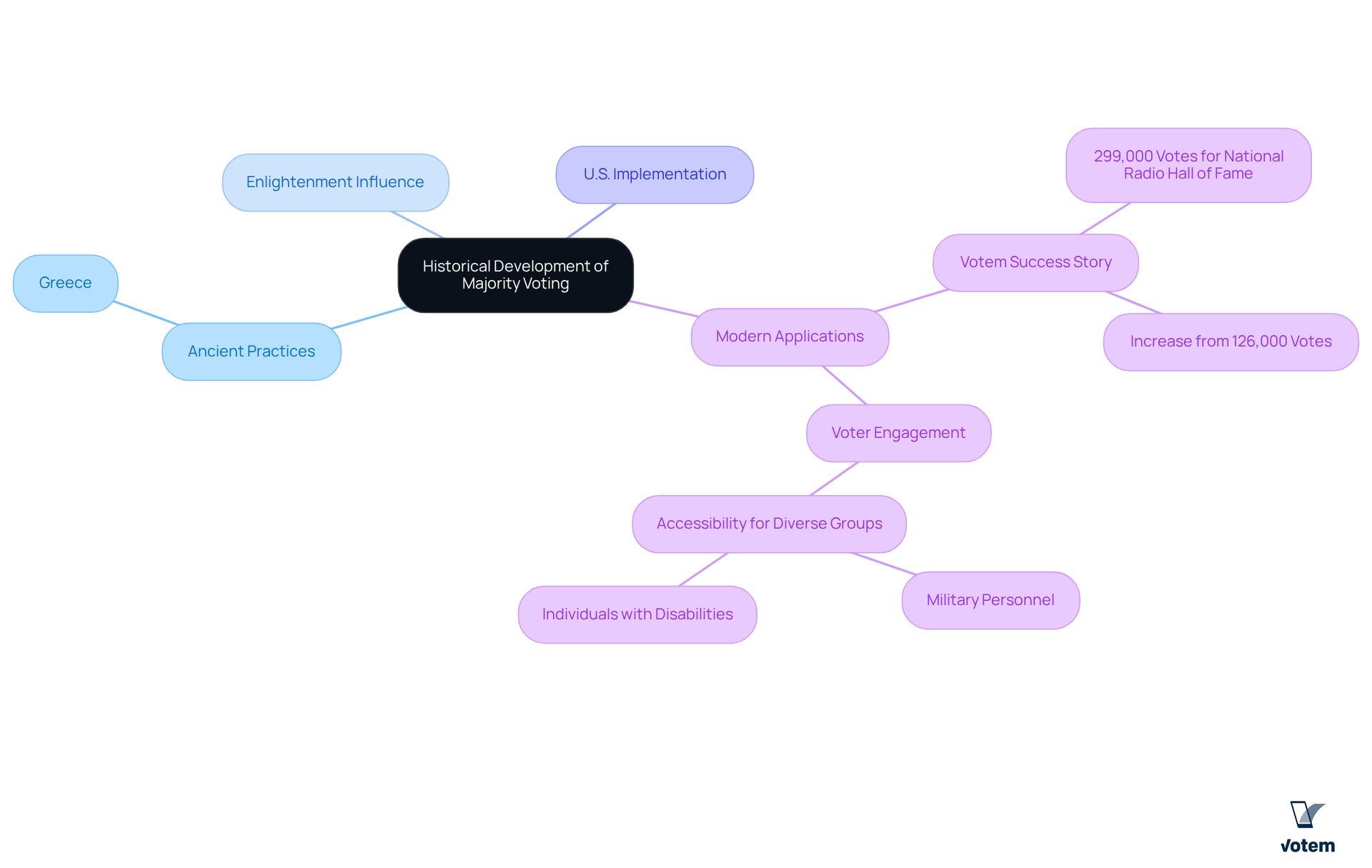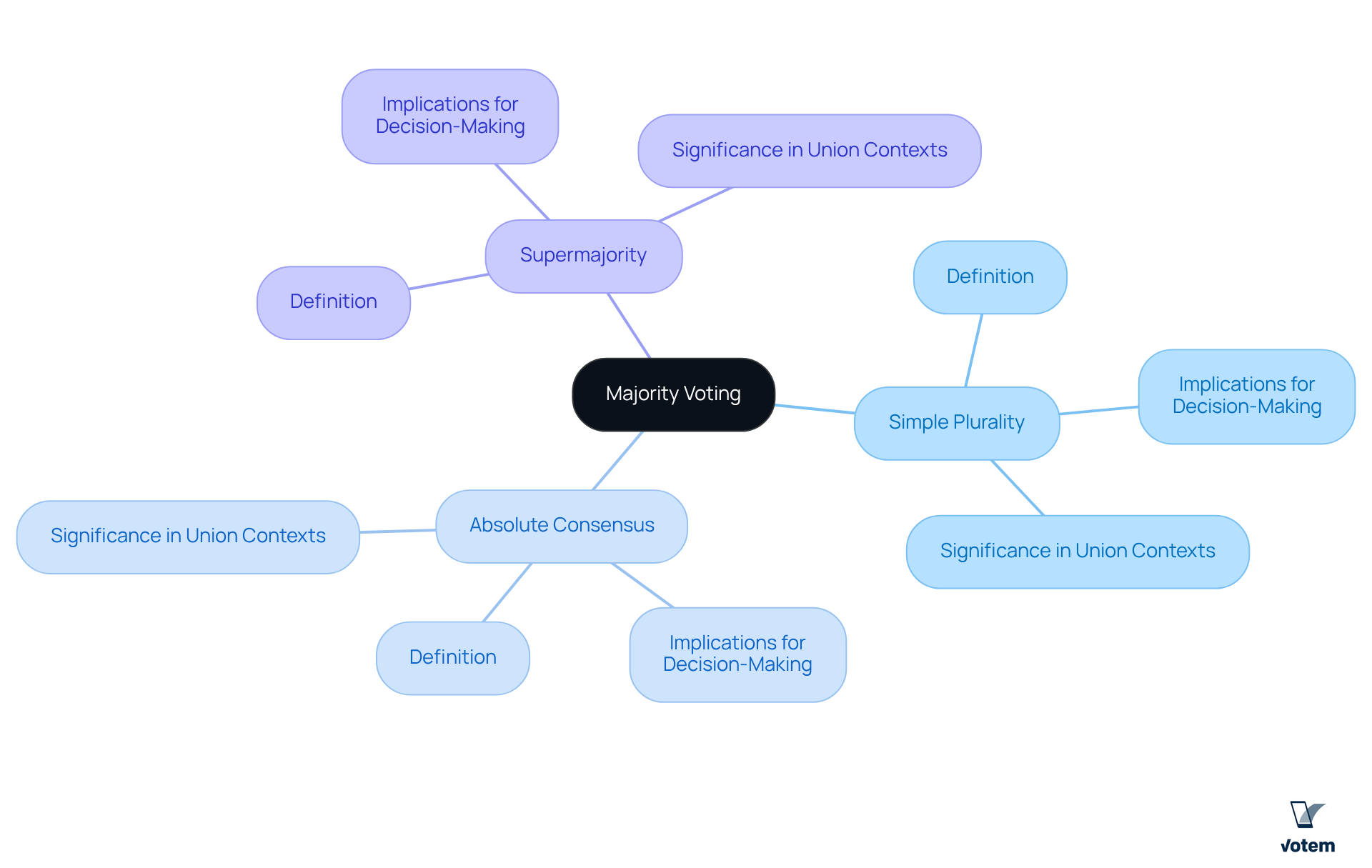Overview
The majority vote serves as a pivotal decision-making process, wherein the option that garners more than half of the votes cast is declared the winner. This mechanism is fundamental in democratic systems, underscoring its importance.
Furthermore, the historical roots of the majority vote reveal its enduring significance, while its various applications in elections and organizations illustrate its versatility.
In addition, modern voting platforms like Votem enhance accessibility and voter participation, ensuring the integrity of the voting process. This evolution in voting technology not only empowers voters but also reinforces the democratic principles that underpin our society.
Introduction
The concept of the majority vote stands as a fundamental pillar of democratic decision-making, where the choice that secures over half the votes is recognized as the winner. This principle not only underlies political elections but also permeates organizations and unions, influencing how collective decisions are reached. However, the apparent simplicity of majority voting masks its inherent complexities; it can, at times, produce unexpected outcomes, raising critical questions about its effectiveness in genuinely reflecting the will of the people.
How can a deeper understanding of the nuances of majority voting enhance democratic engagement and ensure that every voice is acknowledged?
Define Majority Vote: Understanding the Concept
What is refers to a decision-making process wherein the option that secures more than half of the votes cast is declared the winner. For instance, in an election with 100 votes, a candidate must obtain at least 51 votes to take the lead. This system is widely employed by political organizations, labor unions, and community associations, helping to clarify what is majority vote in order to ensure that decisions reflect the preferences of the majority.
Understanding what is majority vote is vital to democratic systems, as it legitimizes the choices made by a group. Furthermore, the adaptable online ballot platform enhances this system by accommodating various election types and ballot methods. It ensures that all eligible voters, including individuals with disabilities and military members, can participate effortlessly and safely.
Votem’s platform features secure and verifiable elections, thereby strengthening the integrity of the predominant ballot system. It is also essential to recognize that dominant voting can sometimes lead to paradoxical outcomes, such as the Condorcet paradox, where prevailing preferences may not align with a clear winner when more than two options are available. This highlights the complexities inherent in decision-making processes.
As Mark Twain wisely remarked, ‘Whenever you find yourself on the side of the greater group, it is time to pause and reflect.’ The organization’s commitment to transparency and confirmability in elections further enhances the reliability of the predominant decision-making process, establishing it as a trustworthy option for groups aiming to uphold democratic principles.
Testimonials from users, including election officials praising Votem’s impact on voter turnout and accessibility, further illustrate the effectiveness of this platform.

Contextualize Majority Vote: Its Role in Elections
In the context of elections, it is essential to understand what is majority vote as it stands as a critical mechanism for determining winners across various political and organizational settings. Frequently utilized in legislative assemblies, a basic plurality is often necessary to enact laws or make choices. For instance, in the United States Congress, many decisions hinge on what is majority vote, which ensures that the perspectives of the greater number of elected representatives dominate.
Furthermore, predominant ballot casting is essential to union elections, enabling members to choose leaders and determine collective bargaining agreements. This process not only enhances democratic engagement but also promotes accountability among elected officials, compelling them to respond to what is majority vote of most constituents. Moreover, statistics reveal that a 10% rise in participation among American women could significantly influence funding for programs that aid women and children, illustrating the profound effects of majority engagement on societal issues, including those pertinent to union members.
The company’s innovative online voting solutions have played a pivotal role in enhancing accessibility and security, as evidenced by testimonials from satisfied clients. For example, one official noted that the introduction of the modern system facilitated broader access for all eligible voters, including military members and individuals with disabilities, marking a notable accomplishment in their electoral process. Additionally, Votem successfully managed the receipt of 299,000 votes for the National Radio Hall of Fame, illustrating what is majority vote and showcasing a substantial increase in voter participation compared to previous years. This underscores how is also employed in community and workplace organizations, where group decisions are made based on the predominant choice, further emphasizing its importance as a foundation of democracy.

Trace the Origin: Historical Development of Majority Voting
The concept of predominant selection traces its roots back to ancient democratic practices, particularly in Greece, where citizens convened to make collective decisions. This foundational principle has since evolved into a cornerstone of democratic governance, particularly during the Enlightenment—a period that championed individual rights alongside collective decision-making. In the United States, the implementation of predominant ballot casting has been significantly influenced by these democratic ideals, leading to its integration into various electoral systems. This historical perspective underscores the in ensuring that the voices of the larger group are acknowledged and valued within democratic frameworks.
In modern contexts, this platform exemplifies the effective application of voting principles by demonstrating what is majority vote through its innovative online voting solutions. Recently, the company successfully managed the receipt of 299,000 votes for the National Radio Hall of Fame, a remarkable increase from the previous year’s total of 126,000 votes. This success story highlights the transformative impact of the organization on voter turnout and accessibility, particularly for diverse voter groups, including military personnel and individuals with disabilities. Testimonials from organizations such as the New Mexico State Republican Party further affirm Votem’s effectiveness, expressing satisfaction with the software’s performance and its critical role in enhancing voter participation. This context is particularly significant for union leadership, as it stresses the necessity of engaging members in the electoral process to safeguard their rights and interests, especially given the assertion that increased voter turnout can lead to substantial policy changes.

Examine Key Characteristics: Variations of Majority Voting
To understand what is majority vote, it is important to recognize that it encompasses several variations, each carrying distinct implications for decision-making processes. The most common type is the simple plurality, where the option receiving more than half of the votes is declared the winner. In contrast, an absolute consensus requires more than half of the total votes, including those not cast, complicating outcomes in larger assemblies. A supermajority, typically set at two-thirds or three-fourths, is often required for significant decisions, such as constitutional amendments or major policy changes.
These variations hold particular significance in union contexts, where different decision-making thresholds can significantly affect the passage of collective agreements or leadership elections. For instance, a supermajority requirement can lead to more rigorous debate and consensus-building, ensuring that decisions reflect a broader agreement among members. Conversely, understanding what is majority vote may expedite decision-making but risks overlooking minority opinions.
Grasping these differences is vital for stakeholders, particularly considering the company’s that improve accessibility and security. The organization’s mission is to broaden access and strengthen trust in elections, simplifying the process and enhancing transparency. As noted by Linda McCulloch, “Implementing Votem’s new, modern system which allowed greater access for all qualified voters from military voters to voters with disabilities was my greatest accomplishment in office.”
Significantly, enhancing voter turnout can have profound effects. For instance, if American women were to increase their participation in elections by just 10 percent, it could lead to substantial policy changes, including the elimination of budget cuts affecting women and children. This increase in turnout could empower union members to influence decisions more effectively, aligning outcomes with the values and needs of the community.
As Abraham Lincoln stated, “Elections belong to the people. It’s their choice… they will simply have to endure their blisters,” highlighting the significance of involvement in the democratic system. Additionally, the case study titled “The Importance of Counting Votes” underscores that the essence of democracy lies not just in voting but in the accurate counting of those votes, emphasizing the critical role of transparency and integrity in the electoral process, which Votem supports as a full-service partner for reliable electoral processes.

Conclusion
Understanding the concept of majority vote is crucial as it serves as the backbone of democratic decision-making processes. It ensures that the preferences of the majority are reflected in outcomes, thereby legitimizing the choices made by groups, organizations, and political bodies alike. Furthermore, the majority vote not only facilitates elections but also encourages active participation, accountability, and transparency within democratic frameworks.
Key insights discussed include:
- The historical evolution of majority voting from ancient practices to its modern applications
- The significance of various voting systems such as simple plurality and supermajority
- The role of innovative platforms like Votem in enhancing voter accessibility and security
These elements highlight how majority voting shapes not only the electoral landscape but also influences societal issues and policies, particularly when considering the impact of increased voter turnout.
Ultimately, the majority vote is more than just a mechanism for decision-making; it embodies the principles of democracy and collective choice. Engaging in the electoral process and understanding the nuances of voting systems can empower individuals and communities to advocate for their interests effectively. As the article emphasizes, every vote counts, and fostering an environment where participation is encouraged can lead to substantial changes in governance and policy that reflect the will of the people.
Frequently Asked Questions
What is a majority vote?
A majority vote is a decision-making process where the option that receives more than half of the votes cast is declared the winner. For example, in an election with 100 votes, a candidate must obtain at least 51 votes to win.
Where is the majority vote system commonly used?
The majority vote system is widely used by political organizations, labor unions, and community associations to ensure that decisions reflect the preferences of the majority.
Why is understanding majority vote important?
Understanding majority vote is vital to democratic systems as it legitimizes the choices made by a group and helps ensure that decisions reflect the will of the majority.
How does Votem’s platform enhance the majority vote system?
Votem’s platform enhances the majority vote system by providing a secure and verifiable online ballot platform that accommodates various election types and ensures participation from all eligible voters, including those with disabilities and military members.
What is the Condorcet paradox in relation to majority voting?
The Condorcet paradox refers to situations in majority voting where prevailing preferences may not align with a clear winner when there are more than two options available, highlighting the complexities of decision-making processes.
How does Votem ensure the integrity of elections?
Votem ensures the integrity of elections through secure and verifiable processes, which strengthen the reliability of the majority vote system.
What do users say about Votem’s impact on elections?
Testimonials from users, including election officials, praise Votem for its positive impact on voter turnout and accessibility in the electoral process.
List of Sources
- Define Majority Vote: Understanding the Concept
- TOP 24 MAJORITY VOTE QUOTES | A-Z Quotes (https://azquotes.com/quotes/topics/majority-vote.html)
- Stakes are high for voting rights as Supreme Court again tackles Louisiana redistricting dispute (https://nbcnews.com/politics/supreme-court/supreme-court-voting-rights-act-louisiana-redistricting-case-rcna236484)
- majority voting (https://oxfordreference.com/display/10.1093/oi/authority.20110803100127808)
- Contextualize Majority Vote: Its Role in Elections
- 15 Inspirational Quotes to Get You Excited About Voting (https://globalcitizen.org/en/content/voting-quotes-inspirational)
- These Inspiring Quotes Will Get You Excited to Vote (https://countryliving.com/life/g24446791/voting-quotes)
- Jesuit Resource – Election Day Quotes (https://xavier.edu/jesuitresource/online-resources/quote-archive1/election-dayvoting)
- Majority vote (https://colelearning.net/cyp/unit3/page5a.html)
- Trace the Origin: Historical Development of Majority Voting
- Quotations about Democracy (https://civiced.org/quotations-about-democracy)
- Jesuit Resource – Election Day Quotes (https://xavier.edu/jesuitresource/online-resources/quote-archive1/election-dayvoting)
- 2: Power to the People- Recalls and Referendums (https://socialsci.libretexts.org/Courses/California_State_University_Fullerton/Cases_in_California_Politics_and_Administration:_Centering_Equity_and_Social_Justice_Issues/01:_Case_Studies/1.02:_Power_to_the_People-_Recalls_and_Referendums)
- Examine Key Characteristics: Variations of Majority Voting
- Jesuit Resource – Election Day Quotes (https://xavier.edu/jesuitresource/online-resources/quote-archive1/election-dayvoting)

